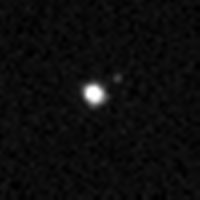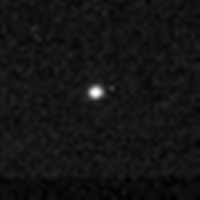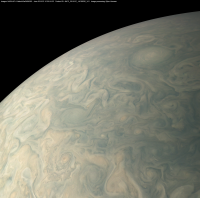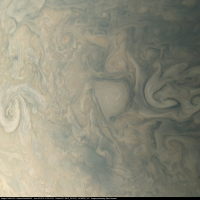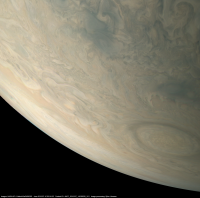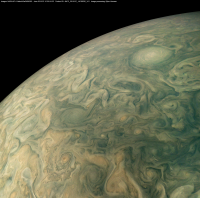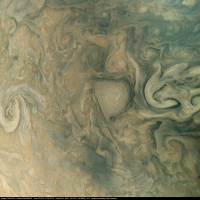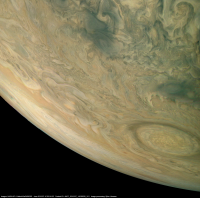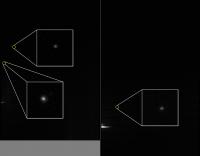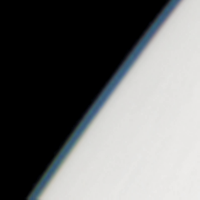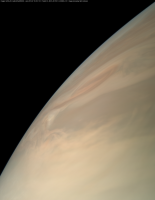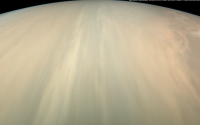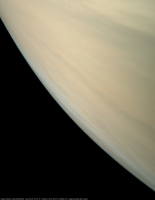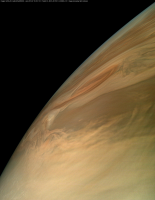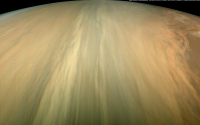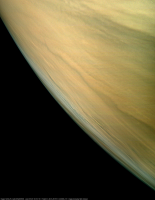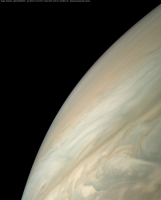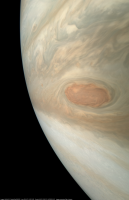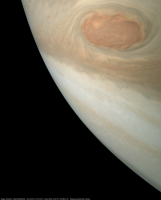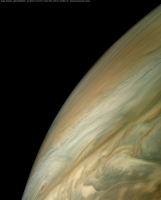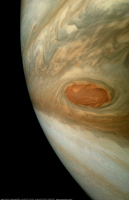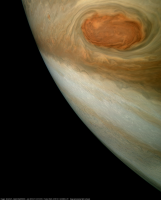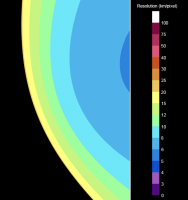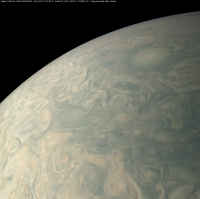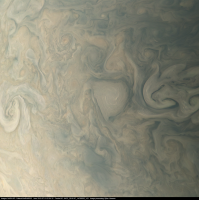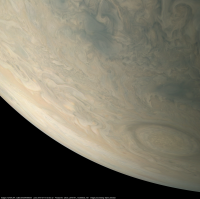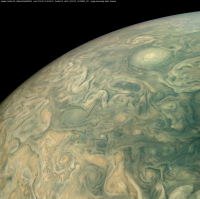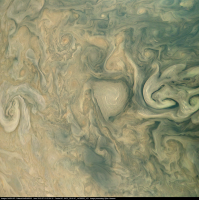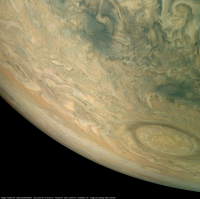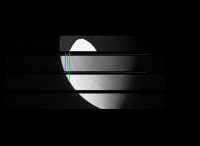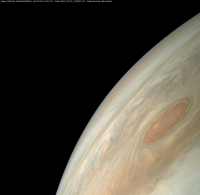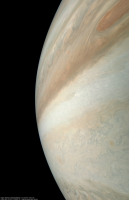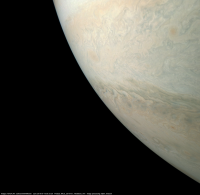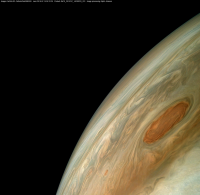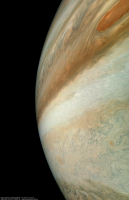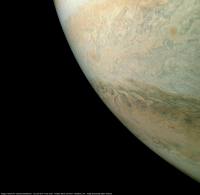Printable Version of Topic
Click here to view this topic in its original format
Unmanned Spaceflight.com _ Juno _ Juno, perijove 14
Posted by: Gerald Jul 16 2018, 03:24 PM
Did anyone happen to observe Jupiter immediately before 2018-07-16T03:47:30 plus light travel time, especially recording a video?
I'm not yet quite sure, But we might have had a small (double?) impact on the night side of Jupiter's north polar region.
Admittedly, it's hard to observe Jupiter's night side from Earth, but maybe there are preceding or follow-up observations, or there has been another presumed event on the dayside at the same time.
Posted by: Floyd Jul 16 2018, 03:49 PM
Exciting way to start perjove 14. Images from your processing pipeline starting to come out tomorrow?
Posted by: Gerald Jul 16 2018, 03:58 PM
I'll start processing as soon as the raws will be posted on the missionjuno website. This requires a full set of SPICE kernel files (which I guess will get available near midnight UTC), and depends also on the pipeline at MSSS and the website operation. But I'm confident, that we'll see first images early tomorrow UTC. Maybe someone can beat me?
Posted by: mcaplinger Jul 16 2018, 07:17 PM
On what basis do you say this?
Posted by: Bjorn Jonsson Jul 17 2018, 01:31 AM
Below are very early, quick and dirty images processed from PJ14_20 ("PJ14 Jet N5"). I'll post improved versions later with better color alignment and slightly higher resolution. First approximately true color/contrast versions:
And enhanced versions:
Posted by: Gustavo B C Jul 17 2018, 01:49 AM
It seems the Hubble https://twitter.com/spacetelelive/ for Prof. Denis Grodent a bit after that time, maybe it'll have caught something?
Posted by: xflare Jul 17 2018, 07:39 AM
Can you provide any more information on these images??
Posted by: Gerald Jul 17 2018, 07:47 AM
I'm working on that. But I'm tired after a 27 hours day by now. After posting the set of reprojected images, I'll provide some context, at least.
Most of the RGB images available thus far, approaching from the north:
#06, #08,
#10, #11,
#13, #16
Posted by: Gerald Jul 17 2018, 07:57 AM
Now some context of the blips in raw images:
I'm going to work on map products, such that it will hopefully be possible to see, whether the blips were at the same position in both images, if projected to Jupiter.
Posted by: Sean Jul 17 2018, 11:57 AM
Thanks for all your efforts Gerald...
https://flic.kr/p/26tdrHd
Details...
22
https://flic.kr/p/27QY1T6
21
https://flic.kr/p/27QY1Yr
20
https://flic.kr/p/27QY284
19
https://flic.kr/p/27QY2gv
18
https://flic.kr/p/27QY2rk
Here is a detail from PJ14_22 made with Matt Brealey's pipeline...
https://flic.kr/p/26tbDxu
and a preliminary output from Brian Swift's pipeline...
https://flic.kr/p/Kx5ADP
Posted by: Gerald Jul 17 2018, 12:40 PM
Those are funtastic results, Seán!
http://junocam.pictures/gerald/uploads/20180717/.
And http://junocam.pictures/gerald/uploads/20180717a/, therefore misaligned for close-up portions.
In the set of drafts, note especially http://junocam.pictures/gerald/uploads/20180717a/JNCE_2018197_14C00022_V01-raw_proc_hollow_sphere_c_pj_out.BMP_thumbnail_.html, with its distinct transparent bluish atmosphere layer along portions of the left (in the image) limb.
Here a 10-fold enlarged and enhanced crop hinting even towards a haze horizon in the upper atmosphere:
Posted by: Sean Jul 17 2018, 01:31 PM
Another processed detail from Matt's output... PJ14_20
https://flic.kr/p/26tmi3G
Posted by: Sean Jul 17 2018, 02:32 PM
Another processed detail from Matt's output... PJ14_22
https://flic.kr/p/KxGpV2
Posted by: mcaplinger Jul 17 2018, 03:00 PM
Note that these were lightning search images in two different colors. The most likely explanation IMHO is that they are, in fact, lightning, but the team is working through various alternatives.
The fact that they look like point sources without any charge bleed or smear despite the high level of TDI suggests to me that their duration was no more than a few tens of milliseconds (total exposure time was about 200 milliseconds).
Posted by: Gerald Jul 17 2018, 05:45 PM
Agreed. A virulent thunderstorm with a high lightning frequency could explain how there can be a bright blip minutes apart in #002 and #003. But just to be sure, a network of impact observers is triggered. More context data from Earth are useful no matter whether it's lightning or impact.
Posted by: mcaplinger Jul 17 2018, 06:09 PM
I guess, although I think the impact hypothesis is so unlikely as to not be worth any particular action (but perhaps that is excessively conservative of me.) However, not providing location information makes any context search difficult (unless it's very, very obvious.)
The two flashes in pj14-002 were at about 60N 220 and 38N 210 and the flash in pj14-003 was at about 60N 280.
Posted by: Explorer1 Jul 17 2018, 06:49 PM
Speaking of collisions:
https://www.theguardian.com/science/2018/jul/17/astronomers-discover-12-new-moons-orbiting-jupiter
12 new moons to welcome to the club, one in an unstable orbit.... 78 total!
(Mods please move to a more appropriate spot if possible; I can't see any other topics in the Jupiter forum)
Posted by: Gerald Jul 17 2018, 11:03 PM
Thanks! I've forwarded your coordinate estimates.
Posted by: Sean Jul 18 2018, 01:49 PM
PJ14_19 portrait from Brian Swift's pipeline
https://flic.kr/p/27SWYvR
Filled gaps, repaired artifacts & added stars.
Posted by: Sean Jul 18 2018, 11:01 PM
PJ14_20/21/22 reprojected using Matt Brealey's Juno Observer tool [alpha]
https://flic.kr/p/29gEfwc
Posted by: Gerald Jul 19 2018, 01:18 AM
http://junocam.pictures/gerald/uploads/20180719/.
And http://junocam.pictures/gerald/uploads/20180719a/ without SPICE and shape model.
Note the varying opacity of the atmosphere along the limb, especially for http://junocam.pictures/gerald/uploads/20180719a/JNCE_2018197_14C00023_V01-raw_proc_hollow_sphere_c_pj_out.BMP_thumbnail_.html.
Posted by: Sean Jul 19 2018, 01:43 PM
Thanks Gerald.
Here is a mosaic of 2 composites made with PJ14_20/21/22 using Matt Brealey's Juno Observer tool... including a fair bit of Photoshop to merge, process & repair.
https://flic.kr/p/KBb4ZB
Posted by: Gerald Jul 19 2018, 02:39 PM
Looks like Matt has been able to fix the geometry glitches he's been working on. So we now have a broader basis for good JunoCam image renditions.
Now finally, yes. I've uploaded http://junocam.pictures/gerald/uploads/20180719b/, just enough to resolve the most distinct blips in #002 and #003. On a global scale they are pretty small. In absolute terms, we are on the scale of a few 100s of km.
And here http://junocam.pictures/gerald/uploads/20180718/ for even more context.
https://en.wikipedia.org/wiki/Anthony_Wesley (Australia) and Clyde Foster (South Africa), at least, have been able to take telescopic images around PJ14. So, we'll get some idea about the larger weather systems nearby.
Posted by: Sean Jul 19 2018, 10:03 PM
There is still some manual placement required but the Juno Observer tool is invaluable for creating new compositions from multiple images, coverage allowing.
Here is a version of PJ14_21 from Gerald warped to a reprojected result from Matt's JO tool...
https://flic.kr/p/MaB9sL
...and a comp without reprojection from Gerald's output...
https://flic.kr/p/29ipD3n
Posted by: Kevin Gill Jul 19 2018, 10:05 PM
A good perijove worth of data. Waiting eagerly for more to be posted :-)
Also, having some trouble with ISIS3 and reprojecting the data for the camera perspective view on the close-up angles. My pipeline uses junocam2isis, spiceinit, cam2map, automos, & map2cam to assemble the images. Works well for the approach and departure views, just not for this sort of view. I figured I'm asking a bit much of map2cam (which uses the middle-most exposure for the camera angle), but curious if I'm missing anything.
Posted by: Sean Jul 19 2018, 11:42 PM
A composite of 4 re-projected images [18,19,20&21] to tease out this oval hiding in the margins... [Brealey/Doran]
https://flic.kr/p/26xGDBd
Posted by: Bjorn Jonsson Jul 20 2018, 12:00 AM
Image PJ14_26 in approximately true color/contrast and then enhanced versions that have been processed with an unsharp mask with several different radius values - basically the radius increases with increasing distance from the horizon.
The spacecraft was only ~3800 km above Jupiter's cloudtops when PJ14_26 was obtained.
Posted by: mcaplinger Jul 20 2018, 01:15 AM
... I figured I'm asking a bit much of map2cam
It's taking a long time for the DSN to downlink everything and there are some partial images stuck in the pipeline.
I'm not much of an ISIS3 expert but map2cam shouldn't be able to introduce errors, so I suspect that something is bad in the processing before that. Are you using the most recent beta version from June? I don't think it's visible from the public site but if you're serious about trying it, PM me and I'll send you the instructions.
Posted by: Kevin Gill Jul 20 2018, 06:11 PM
I'm not much of an ISIS3 expert but map2cam shouldn't be able to introduce errors, so I suspect that something is bad in the processing before that. Are you using the most recent beta version from June? I don't think it's visible from the public site but if you're serious about trying it, PM me and I'll send you the instructions.
I would love to try out any updates to ISIS3. I'm using the current stable release from April.
Posted by: Bjorn Jonsson Jul 20 2018, 09:01 PM
The image from ISIS3 also suggests to me that the problem probably lies earlier in the processing (probably a bad/distorted map for some reason).
However, there was some discussion in a thread here maybe ~2 months ago where ISIS3 was mentioned as part of a discussion concerning optical distortion corrections, the optical axis etc. From the discussion I got the impression that at least until relatively recently ISIS3 probably wasn't handling JunoCam completely correctly - I might be wrong though since I haven't been using ISIS3 to process the JunoCam images (I have been using it mainly for the Cassini images and that's a completely different camera). But in this context it's interesting that I noticed in some of your processed PJ13 images that the images were truncated 'inside' the limb, i.e. a small part of Jupiter very near the limb was missing. At least this was true for images obtained at very close range, I didn't look at other images.
Posted by: Gerald Jul 21 2018, 05:00 AM
#53, and #58:
Note, that several departure images are intentionally overexposed, in order to improve quality near the terminator, especially the polar region with the circumpolar cyclones.
One of the methane band images is unsharp, obviously due to motion blur, but on the other hand, it doesn't show the stray light issues with TDI enabled for long exposure time.
Here links to according http://junocam.pictures/gerald/uploads/20180721/, to http://junocam.pictures/gerald/uploads/20180721a/, and to a http://junocam.pictures/gerald/uploads/20180721b/.
Posted by: Sean Jul 21 2018, 10:08 AM
Thanks Gerald.... here is a detail from your PJ14_30 output.
https://flic.kr/p/26A5pab
Posted by: Sean Jul 21 2018, 11:42 AM
PJ14_36 [Swift/Doran]
https://flic.kr/p/KEqDbk
Posted by: Sean Jul 21 2018, 07:59 PM
PJ14_39 [Swift/Doran]
https://flic.kr/p/29gVFmJ
Posted by: Bjorn Jonsson Jul 21 2018, 08:01 PM
Image PJ14_30 in approximately true color/contrast and enhanced versions. The PJ14 images include beautiful observations of a small red spot near latitude 16.5 degrees south. The spot is slightly more than 5000 km long and its color is similar to the color of the Great Red Spot.
And below is a schematic image showing the resolution in one of the above images (the image that is roughly centered on the spot). The resolution is highest northeast of the red spot.
A subset from the image metadata:
IMAGE_TIME = 2018-07-16T05:28:29.317
MISSION_PHASE_NAME = PERIJOVE 14
PRODUCT_ID = JNCE_2018197_14C00030_V01
SPACECRAFT_ALTITUDE = 7960.3 km
SPACECRAFT_NAME = JUNO
SUB_SPACECRAFT_LATITUDE = -13.7571
SUB_SPACECRAFT_LONGITUDE = 79.186
TITLE = PJ14 South Equatorial Belt north
Resolution at nadir: ~5.4 km/pixel
Posted by: Sean Jul 22 2018, 01:46 PM
Perijove 14 [Swift/Doran]
https://flic.kr/p/27ZULbc
Posted by: mcaplinger Jul 22 2018, 05:58 PM
We've concluded that the issues with the methane images are not stray light per se but are being caused by blooming of charge from the visible bands migrating up into the CH4 region more than we had expected from ground testing.
We tried a couple of things: just turning the TDI off and letting the image blur alongspin (which works but obviously the images are very blurry) and moving the CH4 readout region as far as possible from the visible bands (which showed some modest improvement but isn't a panacea.) The latter will affect the geometric information in a way not currently captured in the instrument metadata. You can expect some similar tests in future perijoves.
Posted by: JRehling Jul 22 2018, 06:52 PM
The thing I love about that "small red spot" is that it's a cyclone rather than an anticyclone like the GRS. I'm not sure if there's any imagery of comparable resolution of a reddish cyclone. That offers some promise for understanding the atmospheric dynamics better.
Posted by: mcaplinger Jul 22 2018, 08:28 PM
I think these features are called "barges" by the Jupiter community, but I'm not sure what distinguishes a barge from a spot if anything.
Posted by: Bjorn Jonsson Jul 23 2018, 08:32 PM
Image PJ14_20 in approximately true color/contrast and enhanced versions:
And a small subset from the image metadata:
IMAGE_TIME = 2018-07-16T05:04:32.049
MISSION_PHASE_NAME = PERIJOVE 14
PRODUCT_ID = JNCE_2018197_14C00020_V01
SPACECRAFT_ALTITUDE = 12204.7
SPACECRAFT_NAME = JUNO
SUB_SPACECRAFT_LATITUDE = 51.3607
SUB_SPACECRAFT_LONGITUDE = 54.3512
TITLE = PJ14 Jet N5
Resolution at nadir: ~8.2 km/pixel
Posted by: Gerald Jul 24 2018, 02:03 PM
Did you consider to replace TDI 64 CH4 images by pairs of TDI 32 images? Blooming would be halved, and TDI would shift the saturated pixels by 32 rows less.
Of course, required storage would be doubled for the same number of collected photons.
Btw., in the meawhile, I've rendered
http://junocam.pictures/gerald/uploads/20180721c/,
http://junocam.pictures/gerald/uploads/20180722/,
and http://junocam.pictures/gerald/uploads/20180724/.
http://junocam.pictures/gerald/uploads/20180723/ are on an early state.
At least http://junocam.pictures/gerald/uploads/20180723/pj14_041_to_049_reg_cropx850y650_800x800_6frames.gif should provide an idea of the motion, and of the type of the involved vortices. The upper left vortex in the GIF is the most southern CPC, approximately the center of an almost pentagonal cluster of six circumpolar cyclones, three of which are shown. Interestingly, a pretty large anticyclone made it into the gap between those three cyclones. Note, that the FFRs (folded filamentary regions) in the lower left are cyclonic, too, like usual. In the upper right, there is another anticyclone, but its rotation isn't well-resolved in this animation. Some of the apparent motion is due to residual global geometrical distortions. And on the raw pixel level, we probably have some aliasing, which might be confused with small-scale motion.
Posted by: mcaplinger Jul 24 2018, 03:01 PM
Even if everything was perfect (geometric registration, digitization, etc.) a pair of images of TDI N/2 would only improve the SNR by sqrt(2) relative to a single image of TDI N.
We did some tests with lower TDI several orbits ago and will likely repeat them with the new CCD readout region, but we don't have a good model for how much this will help, and it's obviously a tradeoff between blooming and SNR.
Posted by: Brian Swift Jul 24 2018, 11:01 PM
Could changes to readout locations (or other instrument command parameters that are not reflected in the metadata) be recorded in the
RATIONALE_DESC and/or DESCRIPTION strings.
Posted by: Brian Swift Jul 24 2018, 11:27 PM
Is the CCD substrate voltage (VSUB) a command-able parameter? If it can be increased, it should reduce blooming.
Posted by: mcaplinger Jul 25 2018, 03:07 AM
No, and it's set by the hardware to a very large value which maximizes antiblooming at the cost of reduced full well. Which doesn't help in this case because the CCD vertical registers are not connected to the substrate.
Posted by: Gerald Jul 25 2018, 03:45 AM
We did some tests with lower TDI several orbits ago and will likely repeat them with the new CCD readout region, but we don't have a good model for how much this will help, and it's obviously a tradeoff between blooming and SNR.
Here is a combined and annotated image derived from #45 and #46, roughly adjusted to the CCD filter layout:
Rather obviously, for this southern MME sequence, the blue filter doesn't cause blooming by itself. But for TDI 64, it's sufficiently saturated to let run through excess electrons from underneath the green filter. Since the green filter is about half as sensitive as the blue filter, it shouldn't cause blooming for TDI 32. But red is a little more sensitive than green. So, it might cause some blooming. Blue could swallow the excess electrons from red, since it wouldn't be saturated.
S/N would be reduced by sqrt(0.5) for a single TDI 32 image, but a pair of TDI 32 images would have a combined S/N a little higher than a single TDI 64. It's mostly a matter of available storage. We'll find software solutions to align the lower TDI images.
It might even be possible to go a little bit above TDI 32 for southern MME, but for this, a more accurate model integration would be required, including the accurate extent of especially the red filter.
I'm presuming, that the electrons behave reasonable as they should for a CCD.
Without better ideas, I'd just suggest to test TDI 32 for southern MME, maybe together with a TDI 64, to be sure about the effect.
Posted by: Gerald Jul 30 2018, 10:35 AM
In the meanwhile, some more renditions are online:
https://youtu.be/qV_2y-BLEr4, http://junocam.pictures/gerald/uploads/20180730/.
http://junocam.pictures/gerald/uploads/20180728/, attention, files are huge!
http://junocam.pictures/gerald/uploads/20180727/.
http://junocam.pictures/gerald/uploads/20180728a/, and http://junocam.pictures/gerald/uploads/20180728b/.
Posted by: avisolo Jul 31 2018, 12:39 AM
Thanks so much Gerald! My humble remix of your awesome video is available here for sharing:
https://vimeo.com/282409567
Posted by: Gerald Aug 4 2018, 03:18 PM
Thank you, Avi! A sound track is something I'll need to work on. It's on my list since years. But there have always been other priorities preventing me from implementation.
The last few days, I finally found some time to take some quantitative look at the varying haze layer at Jupiter's limb.
The analysis is based on a draft processing of PJ14 image #23:
It's squre-root encoded. So all derived quantities in this first approach below will be derived from square-root encoded values, too.
In a first step, I've written an algorithm that finds Jupiter's limb in the draft, at least approximatly.
Here the reduced image with Jupiter's limb reduced to the green lines:
Things rarely work on the first attempt. In this case, it was test run #17, until the software did approximately what I intended.
Posted by: Gerald Aug 4 2018, 03:32 PM
After the limb was available in an explicit way, I've used it to rectify the limb approximately:
There are still some random oscillations induced by the algorithm.
But the quality was sufficient to take a look at the brightness values perpendicular to the limb:
The trained eye may see the brightness function varying along the limb.
Looking at the first derivative makes the variation more obvious:
Locally, we get clearly resolved double peaks.
The same can be rendered for each of the three color channels separately:
This crop shows the transition from a single to a double peak of the brightness gradient:
Of course, a large number of samples along the limb can be compiled into an animation:
 JNCE_2018197_14C00023_limb_diagram_deriveColorMov_try17.mp4 ( 2.74MB )
: 432
JNCE_2018197_14C00023_limb_diagram_deriveColorMov_try17.mp4 ( 2.74MB )
: 432Posted by: Bjorn Jonsson Aug 4 2018, 11:39 PM
In addition to variable amounts of haze it is also possible that the position of the limb deviates slightly from the expected position according to the 'reference' spheroid. A possible reason could be variable cloud altitudes since the bright clouds (e.g. the zones) should be slightly higher in the atmosphere than the dark clouds (e.g. the belts). I have seen possible hints of this in my processing but it is very subtle and could also be due to tiny pointing inaccuracies or even some other factors.
Posted by: Bjorn Jonsson Aug 4 2018, 11:44 PM
And here is image PJ14_33 in approximately true color/contrast versions and in enhanced versions:
Posted by: Sean Aug 15 2018, 03:08 PM
Forgot to post this version of early Perijove 14...
https://flic.kr/p/28HvdQv
Posted by: Sean Aug 16 2018, 12:54 AM
PJ14_21 / Gerald's work
https://flic.kr/p/N12Lyh
Posted by: Brian Swift Sep 7 2018, 02:11 AM
Pipeline updates test image PJ14_36, includes debias/flat-field correction, and new color balance.
NASA/JPL-Caltech/SwRI/MSSS/BrianSwift
https://flic.kr/p/M5phcB
Posted by: Brian Swift Sep 8 2018, 08:01 PM
https://youtu.be/gKE70xVwCrE
Posted by: Sean Jul 20 2019, 11:55 AM
PJ14_20 update [ GE/SD ]
https://flic.kr/p/2gCF2Rp
Powered by Invision Power Board (http://www.invisionboard.com)
© Invision Power Services (http://www.invisionpower.com)

